U.S. Adds 227,000 Jobs as Wage Growth Slows and Underemployment Climbs
The January 2017 jobs data for the United States—the first employment report since President Donald Trump ascended to the Oval Office—shows that the U.S. labor market is improving. Unfortunately, the strong jobs data overshadows slower wage growth and rising underemployment numbers. Regardless, investors who are desperate for any positive economic news, sent overvalued U.S. stocks even higher.
The Bureau of Labor Statistics reported that the U.S. economy added 227,000 jobs in January 2017, the best monthly gain since September 2016. At the same time, the unemployment rate edged up to 4.8%. This exceeds analyst expectations of 180,000 jobs being created, and predictions that the unemployment rate would hold steady at 4.7%. (Source: “The Employment Situation — January 2017,” Bureau of Labor Statistics, February 3, 2017.)
In previous months, the jobs numbers looked solid, but most of the growth came from low-paying part-time jobs. It was a total reversal in January, with full-time job growth across most sectors.
Overall, the number of full-time jobs created in January 2017 increased by 457,000, to a new all-time high of 124.7 million. At the same time, the number of part-time jobs fell by 490,000, to 27.4 million. This marks the biggest drop of part-time jobs since June 2015.
Retail jobs increased by 46,000 in January, construction jobs climbed by 36,000, and jobs in the financial sector went up by 32,000. Demand for waiters and waitresses remains robust, with food services and drinking establishment jobs up by 30,000; the food and beverage industry has added 286,000 jobs over the last year.
Job growth in other major sectors, including mining and logging, manufacturing, wholesale trade, transportation and warehousing, information, and government, showed little change.
Despite surprisingly strong jobs growth, wage growth continues to be a problem. U.S. wage growth was revised down to 2.5%, a slowdown from 2.8% in December, and shy of estimates of 2.7%. While slower wage growth is good for corporate profits, it’s important to remember that consumers drive the economy. If consumers don’t make enough money, it will be difficult for the U.S to ever get out of its seemingly perpetual cycle of slow growth. This will ultimately be a drag on corporate profits.
And finally, the underemployment rate also disappointed in January, rising to 9.4%, the highest level since October 2016.
Euphoric Investors Send Stocks Unsustainably Higher
Add it up, and—despite the solid jobs growth—there are not a lot of reasons to be overly optimistic about the U.S. economy. Moreover, there is too much uncertainty. As a result, it will be difficult for the U.S. Federal Reserve to justify another interest rate hike in March.
Not that investors will mind much.
Both on the campaign trail and after the election, Donald Trump called into question the accuracy of the official unemployment rate, calling the numbers a “joke” and “phony” statistics designed to make Barack Obama look better.
Now that he’s president, Trump is choosing his words a little more carefully. In light of the solid jobs data, President Trump said his administration is “very happy” with the numbers, and said that there is a “great spirit in the country right now.” (Source: “Trump: ‘We’re very happy’ about jobs report,” The Washington Post, February 3, 2017.)
After the initial Trump bump, the markets have been trading sideways since early December 2016. Impatient investors are looking for signs of economic life to send stocks—which are trading at a sliver off of the record high—even higher. The January 2017 jobs data, and Trump’s encouraging words, fit the bill.
The Dow Jones Industrial Average (DJIA) breached 20,000 for the second time in 2017. Meanwhile, yields on government bonds fell. The S&P 500 closed in on 2,300 for just the second time this year. This has made the S&P 500, according to the Case-Shiller cyclically adjusted price-to-earnings (CAPE) ratio, overvalued by 77.8%.
There are a number of reasons why the Case-Shiller CAPE ratio will continue to climb even higher over the coming weeks. First, investors are increasingly optimistic, with 32.8% bullish, which is a 1.2% improvement from the last week of January. In one survey, the number of investors who say they are “neutral” is down by 1.9%, at 33.0%, while those who say they are “bearish” are at around 34%. (Source: “AAII Investor Sentiment Survey,” American Association of Individual Investors, last accessed February 3, 2017.)
The CBOE Volatility Index (VIX Index), better known as the “fear index,” measures the implied volatility of the S&P 500 index options. If the index rises, it means that investors fear a market sell-off. If it’s low, investors are complacent and not worried. The VIX is currently at 11.00, levels not seen since the lead-up to the financial crisis in 2008, when it soared to around 90. Just before the U.S. election, the VIX was near 20.
Third, with optimism high and fear of a correction non-existent, momentum will carry the S&P 500 higher. The S&P 500 is currently 4.55% above its 125-day average. This is higher above the average than has been typical over the last two years. This kind of rapid momentum indicates extreme greed.
As Warren Buffett says, “Be fearful when others are greedy and greedy when others are fearful.”






